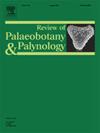Paludification-driven peatlands development and vegetation variations in Alataw Mountains, Northwest China since the Late Holocene: Insights from multiple indicators
IF 1.7
3区 地球科学
Q2 PALEONTOLOGY
引用次数: 0
Abstract
Exploring the impacts of environmental changes on the peatlands evolution and vegetation succession can provide valuable insights for studying the development of wetland ecosystems, especially in arid Northwest China. This study conducted analyses of phytoliths, grain size, organic matter, and humification degree in the ARXT peatland within the Alataw Mountains, Xinjiang, and further investigated the formation, development, and vegetation dynamics of the peatland over the past 3100 years by integrating vegetation Rate-of-change (RoCs) analysis and structural equation modeling. The results indicate that the period from 3100 to 2600 cal yr BP was characterized by a shallow lacustrine environment, followed by the gradual onset of paludification and incipient peat accumulation. Between 2600 and 1000 cal yr BP, the system transitioned to a swamp environment, during which peat underwent stable development. Since 1000 cal yr BP, the peatland has been subjected to a generally cold and dry environment, leading to accelerated decomposition of organic matter and unstable peat accumulation. With the onset of lake paludification, herbaceous taxa dominated by Poaceae and Cyperaceae underwent rapid proliferation. Vegetation RoCs increased markedly during the lake paludification phase (3100–2362 cal yr BP), stabilized throughout the peat accumulation period (2362–720 cal yr BP), and rose again after 720 cal yr BP, concomitant with environmental cooling and declining peatland water levels. Driven by the joint influence of temperature and wetland hydrology, paludification emerged as the primary driver of ARXT peatland development and vegetation dynamics. Human pasture activities exerted no significant influence on vegetation changes in ARXT peatland.
晚全新世以来阿拉塔山泥炭地发育与植被变化:来自多个指标的启示
探讨环境变化对泥炭地演化和植被演替的影响,可以为研究西北干旱地区湿地生态系统的发展提供有价值的见解。本研究对新疆阿拉塔山ARXT泥炭地进行了植物岩、粒度、有机质和腐殖化程度的分析,并结合植被变化率(roc)分析和结构方程模型,进一步研究了过去3100年泥炭地的形成、发展和植被动态。结果表明,3100 ~ 2600 cal yr BP为浅湖环境,随后逐渐发生泥炭化和泥炭初成期。在2600 - 1000 cal yr BP之间,系统过渡到沼泽环境,泥炭在此期间经历了稳定的发展。自1000 cal yr BP以来,泥炭地一直处于普遍寒冷干燥的环境中,导致有机质分解加速,泥炭积累不稳定。随着湖泊酸化的开始,以禾本科和苏科为主的草本类群迅速增殖。随着环境降温和泥炭地水位下降,植被碳足迹在湖泊化期(3100 ~ 2362 cal yr BP)显著增加,在泥炭堆积期(2362 ~ 720 cal yr BP)趋于稳定,在720 cal yr BP之后再次上升。在温度和湿地水文的共同影响下,淤泥化成为ARXT泥炭地发育和植被动态的主要驱动力。人类放牧活动对ARXT泥炭地植被变化无显著影响。
本文章由计算机程序翻译,如有差异,请以英文原文为准。
求助全文
约1分钟内获得全文
求助全文
来源期刊
CiteScore
3.50
自引率
21.10%
发文量
149
审稿时长
6 months
期刊介绍:
The Review of Palaeobotany and Palynology is an international journal for articles in all fields of palaeobotany and palynology dealing with all groups, ranging from marine palynomorphs to higher land plants. Original contributions and comprehensive review papers should appeal to an international audience. Typical topics include but are not restricted to systematics, evolution, palaeobiology, palaeoecology, biostratigraphy, biochronology, palaeoclimatology, paleogeography, taphonomy, palaeoenvironmental reconstructions, vegetation history, and practical applications of palaeobotany and palynology, e.g. in coal and petroleum geology and archaeology. The journal especially encourages the publication of articles in which palaeobotany and palynology are applied for solving fundamental geological and biological problems as well as innovative and interdisciplinary approaches.

 求助内容:
求助内容: 应助结果提醒方式:
应助结果提醒方式:


